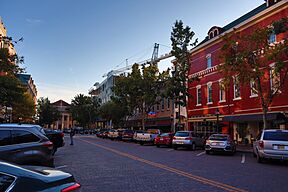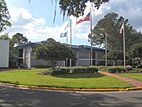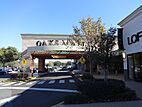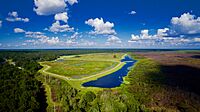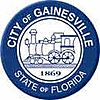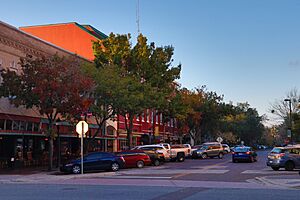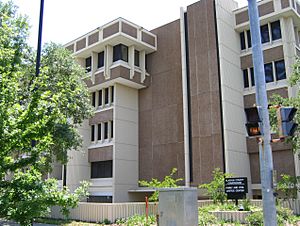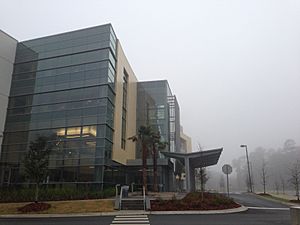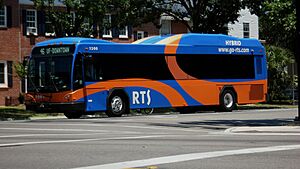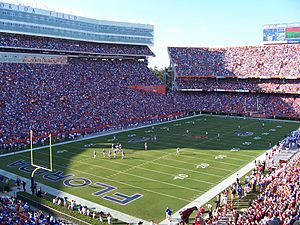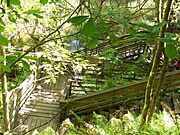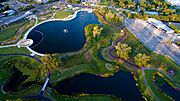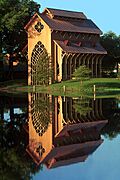Gainesville, Florida facts for kids
Quick facts for kids
Gainesville, Florida
|
||
|---|---|---|
|
Downtown at sunset
Santa Fe College
Century Tower at University of Florida
Ben Hill Griffin Stadium at University of Florida
Sweetwater Wetlands Park at Payne's Prairie
|
||
|
||
| Motto(s):
"Citizen centered. People empowered."
|
||
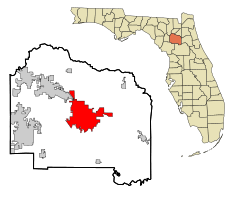
Location in Alachua County, city (as of 2007) in red, and in the state of Florida
|
||
| Country | United States | |
| State | Florida | |
| County | Alachua | |
| Settled | 1854 | |
| Incorporated | April 14, 1869 | |
| Government | ||
| • Type | Commission-Manager | |
| Area | ||
| • City | 64.54 sq mi (167.15 km2) | |
| • Land | 63.36 sq mi (164.11 km2) | |
| • Water | 1.17 sq mi (3.04 km2) 1.74% | |
| Elevation | 152 ft (54 m) | |
| Population
(2020)
|
||
| • City | 141,085 | |
| • Estimate
(2022)
|
145,214 | |
| • Rank | 194th | |
| • Density | 2,226.61/sq mi (859.70/km2) | |
| • Urban | 213,748 (US: 182nd) | |
| • Urban density | 2,437.3/sq mi (941.0/km2) | |
| • Metro | 332,317 (US: 153rd) | |
| • CSA | 400,814 (US: 99th) | |
| Time zone | UTC−5 (EST) | |
| • Summer (DST) | UTC−4 (EDT) | |
| ZIP codes |
32601–32614, 32627, 32635, 32641, 32653
|
|
| Area code | 352 | |
| FIPS code | 12-25175 | |
| GNIS feature ID | 0282874 | |
Gainesville is a city in Florida, United States. It is the main city of Alachua County. In 2022, about 145,212 people lived here. This makes it the biggest city in North Central Florida. It is also the center of a larger area called the Gainesville metropolitan area, which had about 350,903 people in 2022.
Gainesville is famous for being home to the University of Florida. This university is one of the largest public universities in the United States. Its sports teams are called the Florida Gators. They compete in NCAA events.
Contents
History of Gainesville
Gainesville has a long history. About 12,000 years ago, Paleo-Indians lived in this area. However, we don't know if they had permanent homes. Later, different groups of people lived here, like the Deptford and Alachua cultures. When Europeans first arrived, the Potano people lived in the area.
In the 18th century, Spanish settlers started cattle ranches nearby. Florida became part of the U.S. in 1821. Gainesville was officially started in 1854. It was named after Edmund P. Gaines. The town became a city in 1907. The University of Florida moved to Gainesville in 1906.
Geography and Climate
Gainesville is located in Florida. It is about the same distance from the equator as Houston, Texas. The city covers about 64.5 square miles (167.15 square kilometers). Most of this area is land, with a small part being water.
Gainesville is known for its many trees. It has been called a "Tree City, USA" since 1982. Nearly half of the city's land is covered by trees. The city is surrounded by nature, including the large Paynes Prairie wilderness to the south. Gainesville is centrally located in Florida. It is about a two to three-hour drive from major cities like Jacksonville, Orlando, and Tampa.
Gainesville's Weather Patterns
Gainesville has a humid subtropical climate. This means it has hot, tropical-like summers and mild winters. From May to September, the weather is hot and humid. There are often thunderstorms in the afternoons. Average summer temperatures are around 91°F (33°C) during the day.
In winter, temperatures are milder. It freezes about 15 nights a year. Snow is very rare, but traces have been seen a few times. The city's plants are a mix of evergreens and trees that lose their leaves. This means Gainesville has colorful fall leaves and a beautiful spring with many blooming flowers. The city gets about 48 inches (122 cm) of rain each year. Most of the rain falls from June to September.
Cityscape and Architecture
Since the 1990s, Gainesville has worked to improve its downtown area. The goal is to make the city center more lively and reduce the need for new buildings far from the city. This includes building new apartments and shops near the University of Florida.
Gainesville has a mix of old and new buildings. Some historic buildings were lost in the past. However, there is now a focus on saving and restoring older structures. Many buildings are listed on the National Register of Historic Places. These include homes from the 1880s and 1890s in areas like:
- Northeast Gainesville Residential District
- Southeast Gainesville Residential District
- Pleasant Street Historic District
The University of Florida Campus Historic District also has many beautiful old buildings. They are built in a style called Collegiate Gothic.
Some other important historic buildings downtown are:
- Bailey Plantation House (1854)
- Matheson House (1867)
- The Old Post Office (now the Hippodrome State Theatre) (1911)
- Seagle Building (1926), the tallest building downtown.
Population and People
| Historical population | |||
|---|---|---|---|
| Census | Pop. | %± | |
| 1890 | 2,790 | — | |
| 1900 | 3,633 | 30.2% | |
| 1910 | 6,183 | 70.2% | |
| 1920 | 6,860 | 10.9% | |
| 1930 | 10,465 | 52.6% | |
| 1940 | 13,757 | 31.5% | |
| 1950 | 26,861 | 95.3% | |
| 1960 | 29,701 | 10.6% | |
| 1970 | 64,510 | 117.2% | |
| 1980 | 81,371 | 26.1% | |
| 1990 | 84,770 | 4.2% | |
| 2000 | 95,447 | 12.6% | |
| 2010 | 124,354 | 30.3% | |
| 2020 | 141,085 | 13.5% | |
| U.S. Decennial Census | |||
| Race / Ethnicity (NH = Non-Hispanic) | Pop. 2000 | Pop. 2010 | Pop. 2020 | % 2000 | % 2010 | % 2020 |
|---|---|---|---|---|---|---|
| White (NH) | 61,156 | 71,903 | 74,737 | 64.07% | 57.82% | 52.97% |
| Black or African American (NH) | 21,931 | 28,038 | 28,501 | 22.98% | 22.55% | 20.20% |
| Native American or Alaska Native (NH) | 199 | 279 | 237 | 0.21% | 0.22% | 0.17% |
| Asian (NH) | 4,237 | 8,424 | 10,889 | 4.44% | 6.77% | 7.72% |
| Pacific Islander or Native Hawaiian (NH) | 28 | 60 | 47 | 0.03% | 0.05% | 0.03% |
| Some other race (NH) | 157 | 431 | 867 | 0.16% | 0.35% | 0.61% |
| Mixed-race or Multiracial (NH) | 1,627 | 2,832 | 6,362 | 1.70% | 2.28% | 4.51% |
| Hispanic or Latino (any race) | 6,112 | 12,387 | 19,445 | 6.40% | 9.96% | 13.78% |
| Total | 95,447 | 124,354 | 141,085 | 100.00% | 100.00% | 100.00% |
In 2020, Gainesville had 141,085 people living in the city. About 14.1% of the population was under 18 years old. About 10.8% of the population was 65 years or older.
The average household income in Gainesville from 2015-2019 was $37,264. The income per person was $23,018.
Languages Spoken in Homes
Most people in Gainesville speak English at home. In 2019, about 82.90% of residents spoke English. Other languages spoken include:
- Spanish (8.20%)
- Chinese (1.93%)
- French or French Creole (0.96%)
- Vietnamese (0.78%)
- Hindi (0.61%)
- Slavic languages (0.55%)
- Tagalog (0.50%)
- German (0.37%)
- Arabic (0.35%)
- Korean (0.34%)
Economy and Jobs
Gainesville is known for having a low cost of living. This means it's generally cheaper to live here compared to many other U.S. cities. For example, restaurants near the University of Florida are often affordable. While property taxes are a bit high, the average home cost is below the national average. Also, people in Florida do not pay state income taxes.
The job market in Gainesville can be challenging. There are many college-educated people, which means more competition for jobs. The average income for households in Gainesville is a bit lower than the U.S. average.
Gainesville has been a leader in solar power. It was the first city in the U.S. to offer a "feed-in tariff." This program paid homes and businesses for the solar electricity they added to the city's power grid. This helped Gainesville become one of the top cities in the world for solar energy per person.
The famous sports drink Gatorade was invented in Gainesville in the 1960s. It was created to help the University of Florida football team stay hydrated. The university still gets a share of the profits from Gatorade.
Major Employers in Gainesville
The biggest part of Gainesville's economy is the University of Florida. It is the largest employer in the area. The university brings a lot of money into the city from the state and federal government.
Here are the top employers in Gainesville as of 2023:
| No. | Employer | No. of Employees |
|---|---|---|
| 1 | University of Florida | 17,646 |
| 2 | UF Health Shands Hospital | 9,944 |
| 3 | Alachua County School Board | 4,634 |
| 4 | United States Department of Veterans Affairs | 3,438 |
| 5 | Publix | 2,403 |
| 6 | City of Gainesville | 2,265 |
| 7 | North Florida Regional Medical Center | 1,857 |
| 8 | Santa Fe College | 1,388 |
| 9 | Tacachale | 966 |
| 9 | Alachua County | 947 |
Education in Gainesville
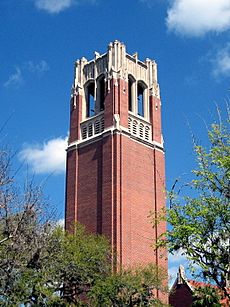
All schools in Gainesville are part of the Alachua County Public Schools district. There are 75 different schools in the county, mostly in the Gainesville area. Gainesville is also home to the University of Florida and Santa Fe College. The University of Florida helps the community a lot financially. Its sports events, like football games, bring in a lot of money. A study in 2019 showed that the university added $16.9 billion to Florida's economy. It also created over 130,000 jobs.
School Desegregation
Gainesville's schools started to become integrated in the 1960s. High schools were fully integrated between 1968 and 1970.
Elementary Schools
- Boulware Springs Charter School
- Caroline Beatrice Parker Elementary School
- Chiles Elementary School
- Duval Elementary School
- Expressions Learning Arts Academy
- Foster Elementary School
- Glen Springs Elementary School
- Hidden Oak Elementary School
- Idylwilde Elementary School
- Lake Forest Elementary School
- Littlewood Elementary School
- Meadowbrook Elementary School
- WA Metcalfe Elementary School
- Norton Knights Elementary School
- Rawlings Elementary School
- Talbot Elementary School
- Terwilliger Elementary School
- Wiles Elementary School
- Williams Elementary School
Middle Schools
Middle schools in Gainesville teach students from 6th to 8th grades.
- Fort Clarke Middle School
- Howard Bishop Middle School
- Kanapaha Middle School
- Lincoln Middle School
- Westwood Middle School
High Schools
High schools in Gainesville teach students from 9th to 12th grades.
- Buchholz High School
- Eastside High School
- Gainesville High School
- Loften High School
Private Schools
- Brentwood School
- Countryside Christian School
- Cornerstone Academy
- Gainesville Country Day School
- Laniakea Montessori School
- Millhopper Montessori School
- Queen of Peace Academy
- St. Patrick Interparish School
- The Rock School
- Trilogy School of Learning Alternatives
- Westwood Hills Christian School
- St. Francis Academy
- Newberry Christian Community School
Colleges and Universities
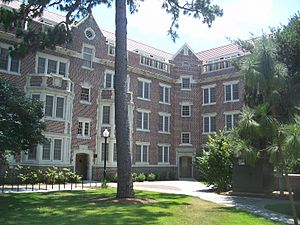
Gainesville is home to several colleges and universities:
- University of Florida
- Santa Fe College
- Saint Leo University (Gainesville Education Center)
- City College (Gainesville campus)
Developmental Research Schools
- P. K. Yonge Developmental Research School
Public Libraries
The Alachua County Library District provides library services to Gainesville and all of Alachua County. You can also borrow books from libraries in nearby counties.
Transportation Around Gainesville
Gainesville has a good road system. Many people also choose to bike to work. In 2009, Gainesville ranked seventh in the U.S. for the percentage of people who biked to work.
Main Roads
Major roads in Gainesville include Interstate 75 and several Florida State Routes.
 I-75 runs along the western side of the city.
I-75 runs along the western side of the city. US 441 is a main road that goes north and south through Gainesville. It runs along the eastern edge of the University of Florida.
US 441 is a main road that goes north and south through Gainesville. It runs along the eastern edge of the University of Florida. SR 20 goes northwest and southeast through the city.
SR 20 goes northwest and southeast through the city. SR 24 goes northeast and southwest. The Gainesville Regional Airport is near this road.
SR 24 goes northeast and southwest. The Gainesville Regional Airport is near this road. SR 26 is a main road that goes east and west through Gainesville.
SR 26 is a main road that goes east and west through Gainesville. SR 121 runs north and south on the western part of the city.
SR 121 runs north and south on the western part of the city. SR 222 runs east and west on the northern part of the city.
SR 222 runs east and west on the northern part of the city.
Gainesville's streets are set up in a grid. Streets are numbered and divided into four sections: NW, NE, SW, and SE. Some major roads are named after towns they lead to, like Waldo Road or Newberry Road.
Train Service
Amtrak Thruway buses connect Gainesville to train stations in Jacksonville and Lakeland. You can also catch an Amtrak train in Palatka, which is about 32 miles (51 km) away.
Gainesville used to have many train lines. The first one arrived in 1859. Over time, train services changed, and some lines were closed. Passenger train service to Gainesville ended in 1971.
Airport and Buses
Gainesville has a public transportation system called Gainesville Regional Transit System (RTS). It is Florida's fourth-largest public transit system. The city also has the Gainesville Regional Airport ("GNV"). This airport offers daily flights to several major cities like Atlanta and Miami.
Culture and Fun
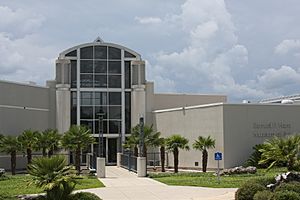
Gainesville is known for its support of the arts. Each year, two big art festivals bring artists and visitors from all over the southeastern U.S.
Places to visit for culture include:
- Florida Museum of Natural History
- Harn Museum of Art
- Hippodrome State Theatre
- Curtis M. Phillips Center for the Performing Arts
The University of Florida College of the Arts offers many performances and talks. Most of these are free or low-cost. Gainesville is also home to Theatre Strike Force, the university's improv comedy group.
In 2003, Gainesville was named the "Healthiest Community in America." This was because many local businesses worked together to promote health and wellness.
Music Scene in Gainesville
Gainesville has a lively music scene. Many famous bands and musicians started here, including Tom Petty and the Heartbreakers, Stephen Stills, and Less Than Jake. It's also home to independent music labels.
From 1987 to 1998, Gainesville had a very active rock music scene. Actor River Phoenix and his band Aleka's Attic were a big part of it. The city is still known for its strong music community. In 2008, Blender magazine called it the "Best Place to Start a Band in the United States." They mentioned the large student population, affordable rent, and friendly music venues.
Sports and Teams
The Florida Gators are the sports teams of the University of Florida. They compete in the Southeastern Conference. The Gators have won many national championships in different sports. These include men's basketball, football, women's soccer, baseball, gymnastics, and tennis.
The Gainesville Raceway opened in 1969. It is a dragstrip that hosts the Gatornationals. This is one of the four major races in the NHRA.
Startup Businesses
Gainesville is a growing place for new businesses, especially in technology. There are over 160 high-growth companies in the area. Many organizations in Gainesville help these new businesses grow.
Since 2006, when Grooveshark (a music streaming service) was founded here, more tech startups have started in Gainesville. These include companies like Digital Brands and SharpSpring. The city even celebrates "Josh Greenberg Day" each April. This day honors the late founder of Grooveshark and his help to the city's startup community.
Yearly Cultural Events
- The Spring Arts Festival, held in early April by Santa Fe College, is known for its unique artwork.
- The Downtown Festival and Art Show, held each fall, attracts many artists and over 100,000 visitors.
- The Hoggetowne Medieval Faire has been a popular event for over 20 years.
- The Fest is a multi-day music festival held every year since 2002.
Media and News
Print Media
Gainesville has two main newspapers: The Gainesville Sun and The Independent Florida Alligator. The Alligator is the student newspaper for the University of Florida and Santa Fe College. A newer paper, Mainstreet Daily News, started printing weekly in 2022.
Radio Stations
Gainesville has 13 radio stations. Some of these, like WRUF and WUFT-FM, are run by students at the University of Florida. WUFT-FM is the local NPR station.
Television Stations
Gainesville has several broadcast television stations:
- WCJB (ABC/CW affiliate)
- WGFL (CBS/MyNetworkTV affiliate)
- WNBW (NBC affiliate)
- WOGX (Fox station)
- WUFT (PBS station, affiliated with the University of Florida)
Gainesville also has a local cable TV channel called Community 12TV. It shows local government meetings and other public programs.
Places to Visit
- 34th Street Wall
- Baughman Center
- Ben Hill Griffin Stadium at Florida Field
- Bivens Arm
- Cade Museum for Creativity and Invention
- Civic Media Center
- Depot Park
- Devil's Millhopper Geological State Park
- Florida Museum of Natural History, including the Butterfly Rainforest exhibit
- Gainesville-Hawthorne Trail State Park
- Harn Museum of Art
- Helyx Bridge
- Hippodrome State Theatre
- Lake Alice
- Morningside Nature Center
- The Oaks Mall
- Stephen C. O'Connell Center
- William Reuben Thomas Center
- Points of interest in Gainesville, Florida
Sister Cities
Gainesville has several sister cities around the world. These partnerships help promote cultural understanding and exchange.
 Deir Alla, Jordan
Deir Alla, Jordan Duhok, Iraq (2006)
Duhok, Iraq (2006) Jacmel, Haiti
Jacmel, Haiti Kfar Saba, Israel (1998)
Kfar Saba, Israel (1998) Matagalpa, Nicaragua
Matagalpa, Nicaragua Mejdlaya, Lebanon (2015)
Mejdlaya, Lebanon (2015) Novorossiysk, Russia (1982)
Novorossiysk, Russia (1982) Qalqilya, Palestine
Qalqilya, Palestine Rzeszów, Poland (2013)
Rzeszów, Poland (2013)
See also
 In Spanish: Gainesville (Florida) para niños
In Spanish: Gainesville (Florida) para niños


